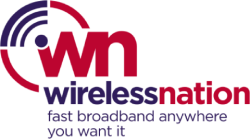What is rural broadband?
Rural broadband refers to specific broadband products (most commonly wireless broadband) catered for those outside of the standard broadband network.
For example, while fibre is by far the go-to option for most urbanites, many rural communities don’t have the option. Even 4G wireless broadband, which utilises the same cell towers that provide mobile data to deliver broadband to the home, may not be available.
And even if it is, the sad reality is that the smaller number of available cell towers (and available radio spectrum), along with the cost of the upkeep and servicing of their remote locations, means a rural customer on a wireless broadband plan may have to pay more for it, and face data caps.
For example, 2degrees offers unlimited wireless broadband for $75/month but just 120GB of 2degrees’ rural wireless broadband costs $85/month, despite using the same network and modems.
It is worth noting that thanks to the Rural Broadband Initiative and New Zealand’s growing mobile and broadband coverage, many of the standard broadband plans on offer from large retailers are now suitable for customers regardless of where they live. As result, you may not need a rural broadband plan for your rural address, you might be able to grab a standard 4G wireless plan instead.
Check what’s available at your address
Before we get to which rural broadband plans are available, it pays to check what your options are. You may be surprised just how far the fibre network has grown! Alternatively, you may find that standard 4G wireless broadband is an option for you, in which case it’ll be cheaper and have the option of no data caps.
Shop around
Do note that depending on how rural your location is, you may need to get a rural wireless plan. In this case, there is a wide range of providers available to you, as most regions have small providers that service the local area in addition to the larger nationwide providers.
Do note that not all rural providers service the same addresses. For example, one rural address may be within the Spark network’s 4G wireless range (and any rural providers using the Spark network) but not Vodafone’s or 2degrees’.
In this case, one provider may tell you your only option is an old ADSL cable, while another will say your only option is wireless broadband. So it pays to check what’s available at your address with multiple providers.
A good place to start is checking with providers that use the same network as your current phone plan. So if your phone is using the 2degrees network and gets great reception at your address, it may pay to start with 2degrees’ rural wireless plans and/or any other providers that piggyback off the 2degrees network.
Alternatively, consulting a local provider for your region may be of more use and can provide more accurate and tailored information.
Starlink satellite internet
For those truly cut off, satellite internet has long been a last resort. Typically these plans have been expensive and slow.
However, the recent introduction of Starlink means many rural customers may be able to access faster speeds than ever before. Starlink utilises thousands of low-orbit satellites that, according to the Starlink website, complete around 70 round trips of data in the time it takes the average geostationary satellite to complete one.
It is worth noting that while Starlink may be able to provide truly remote customers with faster than ever before internet, it remains a rather expensive option.
Currently, Noel Leeming sells starter kits for $520, while the service itself will set you back $159/month. Although, while that’s expensive compared to what city dwellers pay for broadband, compared to other rural broadband plans, $159/month for unlimited data isn’t bad.
However, Starlink is typically more catered to tech-savvy users, due to its self-install and lack of comprehensive local customer support. So if technology isn’t your strong suit, bear that in mind.
Lastly, it’s worth noting that there are several other providers in New Zealand offering satellite internet services, so it’s worth consulting local rural broadband providers. While these will likely offer slower speeds, the more local focus may offer better ongoing support and customer service.
→ Related article: Starlink Satellite Internet: All You Need to Know
How fast is rural broadband?
The answer to this question depends on a lot of factors. For starters, as mentioned above, just because you live at a rural address, it doesn’t necessarily mean you need rural broadband.
If you can access the fibre network, you can expect the same fast speeds as the rest of the country.
If you’re on ADSL/VDSL, your speeds can vary depending on how far you are from the nearest cabinet/exchange (which for rural addresses, can be quite far). While speeds for those on wireless depend on factors such as how far they are from the nearest cell tower and how many people in the area are using it at once.
Below you can see a general speed guide for different internet types. Note that actual speeds, particularly for rural addresses, may differ.
Broadband speeds by type
You can see the average speeds and latency for different types of broadband, according to the latest Measuring Broadband New Zealand Report below:
| Broadband | Download speeds (Mbps) |
Upload speeds (Mbps) |
Latency (ms) |
| ADSL | 10 | 0.7 | 26.4 |
| VDSL | 43 | 11 | 19.7 |
| Fixed Wireless | 37.1 | 18 | 47.5 |
| Fibre 300 | 315.4 | 109.7 | 6.2 |
| Fibre Max | 877.4 | 496.8 | 5.4 |
| Starlink Satellite* | 100-200 | 10-20 | 20-40 |
*Starlink figures are taken from the Starlink website, not the MBNZ report. Furthermore, other satellite broadband plans will likely have speeds well below those offered by Starlink, due to the nature of Starlink’s low-orbit satellite network.
Compare broadband providers for free with Canstar!
Best rural broadband plans
If your property has access to Fibre or Fixed Wireless broadband, then check out one of the stories below for a breakdown of the best broadband plans on offer:
Otherwise, if you need a rural broadband plan, see the list below for an overview of what rural wireless and satellite plans are on offer from some of the major broadband providers.
All plans and pricing are accurate at the time of writing (January 2023) and should be used as a guide only.

Farmside (Vodafone)
Farmside has long been a leading provider of rural broadband. It is now owned by Vodafone and handles the rural broadband side of the business. Still based out of Timaru, with a strong rural focus, (customer service is available by phone seven days a week) its range of plans include fibre, fixed wireless, ADSL, VDSL and satellite, with both nationwide and rural options available.
So, as mentioned above, if your rural address doesn’t need a rural plan, Farmside still has options for those who prefer a rural-focused provider that understands your needs and challenges, even if you don’t need a rural plan.
Farmside rural broadband plans include:
RBI Wireless 120GB or 200GB ($95.99/month or $155.99/month)
- Option to add landline for $10/month
- 4G modem included ($20 delivery fee)
- Data booster packs available for purchase if more data needed
- $99 standard installation fee if aerial is needed (Additional travel costs may apply. Non-standard installation may incur additional fees)
Satellite broadband (from $99/month)
- 10GB data – $99/month; 40GB data – $149/month; Unlimited data – $199/month
- 40GB plan includes unlimited off-peak data (midnight-4pm daily)
- Option to add landline for $10/month
- $799 standard installation cost (Additional travel costs may apply. Non-standard installation may incur additional fees)

Wireless Nation
Wireless Nation is a major provider of both rural broadband and portable broadband, for boats, motorhomes etc. The Wireless Nation team is all local and on hand for any help you may need.
Wireless Nation rural broadband plans include:
300GB Rural Wireless Broadband ($129.90/month)
- Endless data at reduced speeds after 300GB cap reached
- Option to add landline for $23/month
- $329 modem required ($16.95 shipping + handling)
- If aerial is required further installation costs may apply

2degrees
2degrees offers just one broadband plan:
170GB Rural Wireless 4G ($85/month)
- Free modem on 12-month contract
- Additional data automatically charged at $20 per 20GB block
- $10/month discount for 2degrees mobile customers
Spark
Spark‘s range of rural wireless plans include:
60GB rural wireless and landline ($95.99/month)
- If antenna is required plan is an additional $10/month
- If you reach your monthly data cap, you will automatically receive 10GB of additional data for $10.
Naked rural Wireless 200GB or 350GB ($95.99/month or $155.99/month)
- Option to add a landline for $10/month
- If antenna is required plan is an additional $10/month
- If you reach your monthly data cap, you will automatically receive 10GB of additional data for $10 (50GB for $10 on 350GB plan)
Starlink
While not rural specific, Starlink satellite internet is likely the best value to those outside of the fibre network and/or standard 4G wireless network.
Starlink offers just one broadband plan for fixed addresses:
- Unlimited data
- $520 starter kit (self-install)
- $159/month
- No contracts
Other providers
A comprehensive list of rural broadband providers is available and can be found on the broadbandmap website.
It’s worth noting that a more local provider may be a good option for very rural customers, as some rural broadband providers set up their own infrastructure that is separate from the wireless network operated by Spark, Vodafone and 2degrees. These hyper-local networks can act like wi-fi hotspots across the region, providing coverage to areas outside of the national networks.
Compare broadband providers for free with Canstar!
 About the author of this page
About the author of this page
This report was written by Canstar Content Producer, Andrew Broadley. Andrew is an experienced writer with a wide range of industry experience. Starting out, he cut his teeth working as a writer for print and online magazines, and he has worked in both journalism and editorial roles. His content has covered lifestyle and culture, marketing and, more recently, finance for Canstar.
Enjoy reading this article?
You can like us on Facebook and get social, or sign up to receive more news like this straight to your inbox.
By subscribing you agree to the Canstar Privacy Policy




Share this article